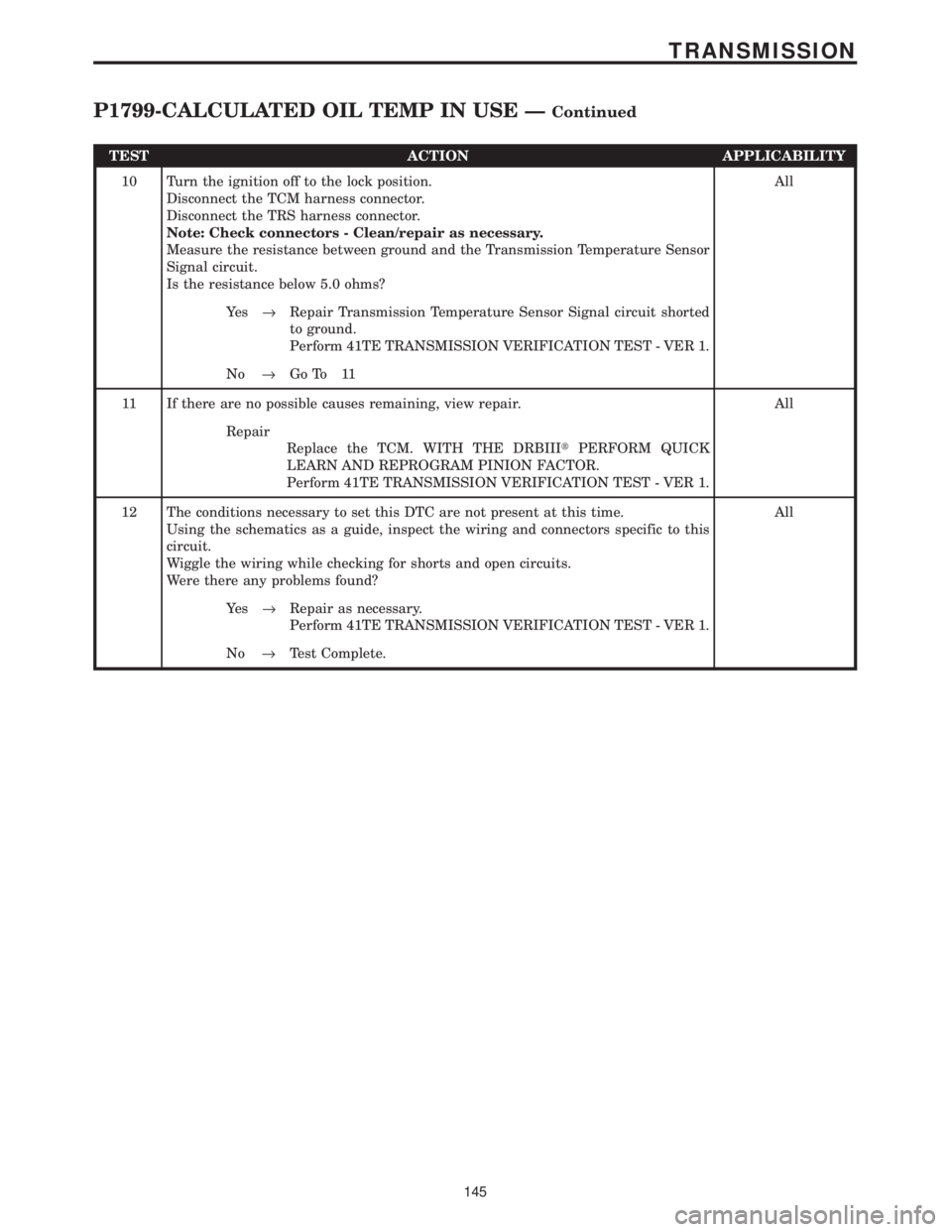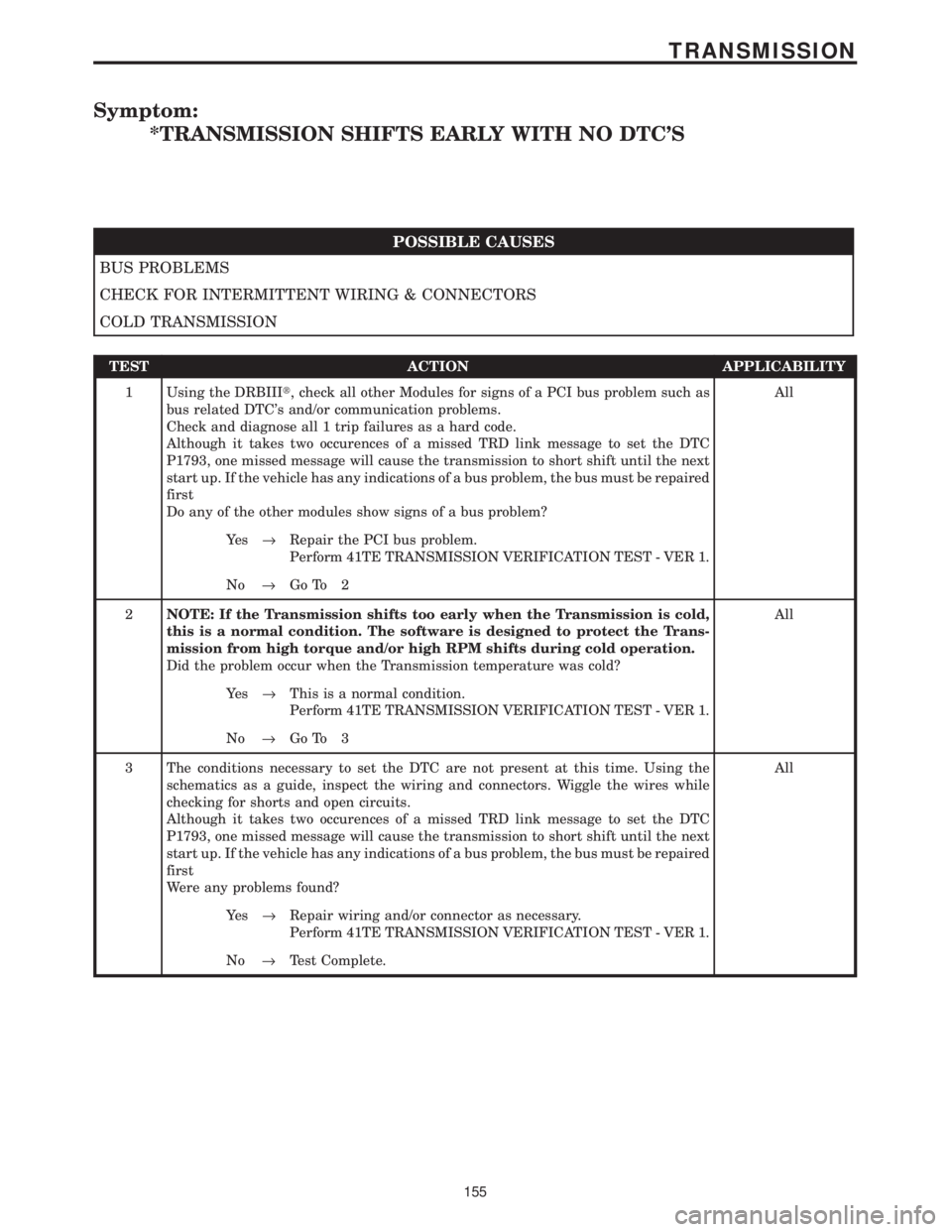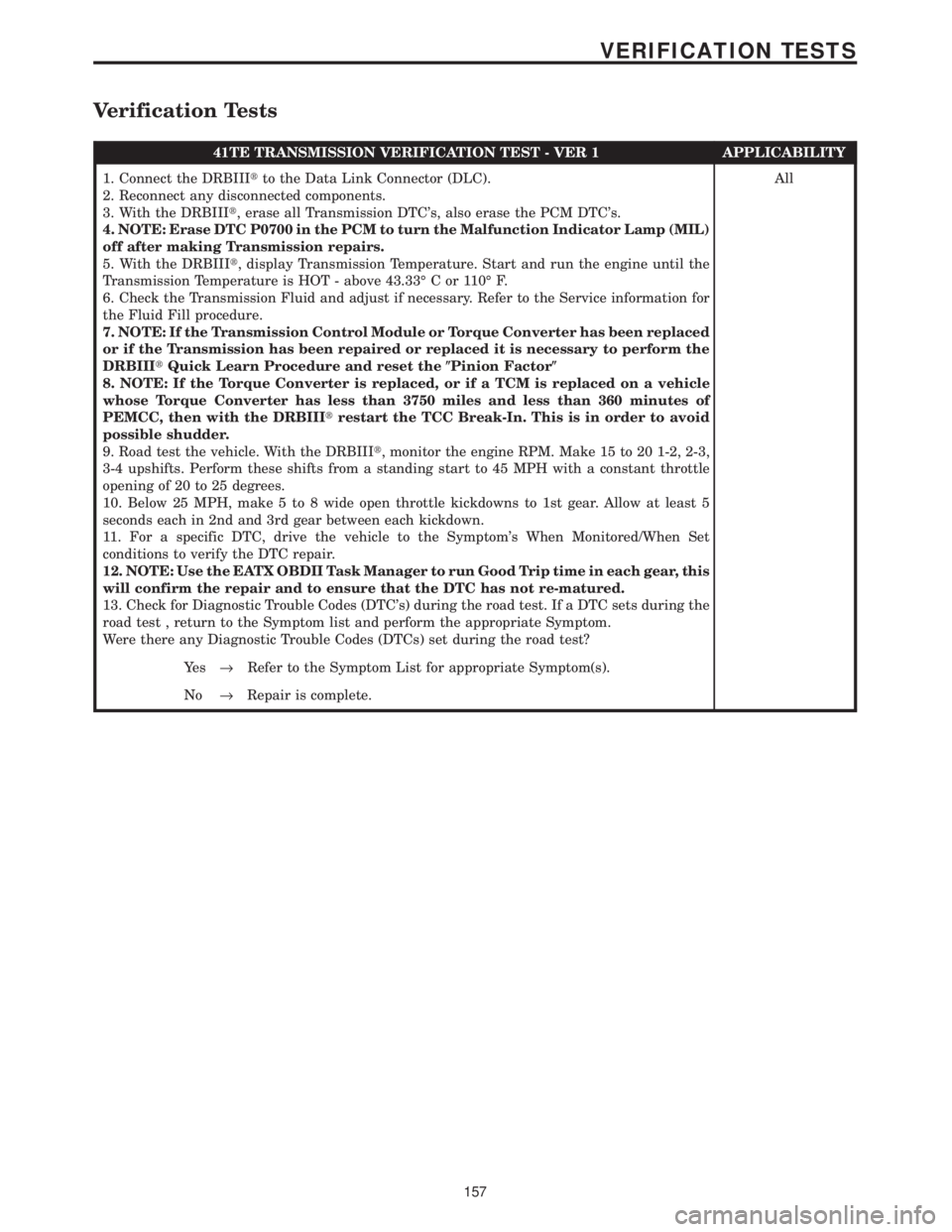Page 4249 of 4284

TEST ACTION APPLICABILITY
10 Turn the ignition off to the lock position.
Disconnect the TCM harness connector.
Disconnect the TRS harness connector.
Note: Check connectors - Clean/repair as necessary.
Measure the resistance between ground and the Transmission Temperature Sensor
Signal circuit.
Is the resistance below 5.0 ohms?All
Ye s®Repair Transmission Temperature Sensor Signal circuit shorted
to ground.
Perform 41TE TRANSMISSION VERIFICATION TEST - VER 1.
No®Go To 11
11 If there are no possible causes remaining, view repair. All
Repair
Replace the TCM. WITH THE DRBIIItPERFORM QUICK
LEARN AND REPROGRAM PINION FACTOR.
Perform 41TE TRANSMISSION VERIFICATION TEST - VER 1.
12 The conditions necessary to set this DTC are not present at this time.
Using the schematics as a guide, inspect the wiring and connectors specific to this
circuit.
Wiggle the wiring while checking for shorts and open circuits.
Were there any problems found?All
Ye s®Repair as necessary.
Perform 41TE TRANSMISSION VERIFICATION TEST - VER 1.
No®Test Complete.
145
TRANSMISSION
P1799-CALCULATED OIL TEMP IN USE ÐContinued
Page 4251 of 4284

TEST ACTION APPLICABILITY
5 Turn the ignition off to the lock position.
Disconnect the Front Control Module harness connector.
Disconnect the Brake Shift Interlock harness connector.
Note: Check connectors - Clean/repair as necessary.
Measure the resistance of the Brake Shift Interlock Feed Circuit from the Front
Control Module connector to the Brake Shift Interlock harness connector.
Is the resistance above 5.0 ohms?All
Ye s®Repair the Brake Shift Interlock Feed Circuit for an open.
No®Go To 7
6 Turn the ignition off to the lock position.
Disconnect the Front Control Module harness connector.
Disconnect the Brake Shift Interlock harness connector.
Note: Check connectors - Clean/repair as necessary.
Measure the resistance of the Brake Shift Interlock Control Circuit from the Front
Control Module connector to the Brake Shift Interlock harness connector.
Is the resistance above 5.0 ohms?All
Ye s®Repair the Brake Shift Interlock Control Circuit for an open.
No®Go To 7
7 If there are no possible causes remaining, view repair. All
Repair
Replace the Front Control Module in accordance with the Service
Information.
8 The conditions necessary to set this DTC are not present at this time.
Using the schematics as a guide, inspect the wiring and connectors specific to this
circuit.
Wiggle the wiring while checking for shorts and open circuits.
Were there any problems found?All
Ye s®Repair as necessary.
No®Test Complete.
147
TRANSMISSION
*BRAKE SHIFT INTERLOCK OUTPUT OPEN ÐContinued
Page 4258 of 4284

Symptom:
*TRANSMISSION NOISY WITH NO DTC'S PRESENT
POSSIBLE CAUSES
INCORRECT FLUID LEVEL
INTERNAL TRANSMISSION PROBLEM - NOISY
INTERNAL TRANSMISSION PROBLEM - NOISY WHILE STANDING STILL
TEST ACTION APPLICABILITY
1 Check the Transmission Fluid Level per the Service Information.
Is the fluid level OK?All
Ye s®Go To 2
No®Adjust fluid level and repair cause of incorrect fluid level.
2 Place vehicle on hoist.
WARNING: BE SURE TO KEEP HANDS AND FEET CLEAR OF ROTATING
WHEELS.
Run vehicle on hoist under conditions necessary to duplicate the noise.
NOTE: It may be necessary to test drive the vehicle to duplicate the noise.
Using Chassis Ears or other suitable listening device, verify the source of the noise.
Is the noise coming from the transmission?All
Ye s®Go To 3
No®Test Complete.
3 With the shift lever in neutral, raise the engine speed and listen to the noise.
NOTE: THE RADIO MUST BE TURNED OFF. Alternator noise can come
through the speakers and be misinterpreted as Transmission Pump Whine.
This can happen even with the volume turned down.
Does the noise get louder or change pitch while the engine speed is changing?All
Ye s®Go To 4
No®Go To 5
4 If there are no possible causes remaining, view repair. All
Repair
Repair internal transmission problem as necessary. Inspect all of
the transmission components for signs of wear. If no problems
found, replace the Transmission oil pump..
5 If there are no possible causes remaining, view repair. All
Repair
Repair internal transmission problem as necessary. Inspect all of
the transmission components for signs of wear. Pay particular
attention to bearings, pinion gears, etc. Repair or replace as
necessary.
154
TRANSMISSION
Page 4259 of 4284

Symptom:
*TRANSMISSION SHIFTS EARLY WITH NO DTC'S
POSSIBLE CAUSES
BUS PROBLEMS
CHECK FOR INTERMITTENT WIRING & CONNECTORS
COLD TRANSMISSION
TEST ACTION APPLICABILITY
1 Using the DRBIIIt, check all other Modules for signs of a PCI bus problem such as
bus related DTC's and/or communication problems.
Check and diagnose all 1 trip failures as a hard code.
Although it takes two occurences of a missed TRD link message to set the DTC
P1793, one missed message will cause the transmission to short shift until the next
start up. If the vehicle has any indications of a bus problem, the bus must be repaired
first
Do any of the other modules show signs of a bus problem?All
Ye s®Repair the PCI bus problem.
Perform 41TE TRANSMISSION VERIFICATION TEST - VER 1.
No®Go To 2
2NOTE: If the Transmission shifts too early when the Transmission is cold,
this is a normal condition. The software is designed to protect the Trans-
mission from high torque and/or high RPM shifts during cold operation.
Did the problem occur when the Transmission temperature was cold?All
Ye s®This is a normal condition.
Perform 41TE TRANSMISSION VERIFICATION TEST - VER 1.
No®Go To 3
3 The conditions necessary to set the DTC are not present at this time. Using the
schematics as a guide, inspect the wiring and connectors. Wiggle the wires while
checking for shorts and open circuits.
Although it takes two occurences of a missed TRD link message to set the DTC
P1793, one missed message will cause the transmission to short shift until the next
start up. If the vehicle has any indications of a bus problem, the bus must be repaired
first
Were any problems found?All
Ye s®Repair wiring and/or connector as necessary.
Perform 41TE TRANSMISSION VERIFICATION TEST - VER 1.
No®Test Complete.
155
TRANSMISSION
Page 4261 of 4284

Verification Tests
41TE TRANSMISSION VERIFICATION TEST - VER 1 APPLICABILITY
1. Connect the DRBIIItto the Data Link Connector (DLC).
2. Reconnect any disconnected components.
3. With the DRBIIIt, erase all Transmission DTC's, also erase the PCM DTC's.
4. NOTE: Erase DTC P0700 in the PCM to turn the Malfunction Indicator Lamp (MIL)
off after making Transmission repairs.
5. With the DRBIIIt, display Transmission Temperature. Start and run the engine until the
Transmission Temperature is HOT - above 43.33É C or 110É F.
6. Check the Transmission Fluid and adjust if necessary. Refer to the Service information for
the Fluid Fill procedure.
7. NOTE: If the Transmission Control Module or Torque Converter has been replaced
or if the Transmission has been repaired or replaced it is necessary to perform the
DRBIIItQuick Learn Procedure and reset the(Pinion Factor(
8. NOTE: If the Torque Converter is replaced, or if a TCM is replaced on a vehicle
whose Torque Converter has less than 3750 miles and less than 360 minutes of
PEMCC, then with the DRBIIItrestart the TCC Break-In. This is in order to avoid
possible shudder.
9. Road test the vehicle. With the DRBIIIt, monitor the engine RPM. Make 15 to 20 1-2, 2-3,
3-4 upshifts. Perform these shifts from a standing start to 45 MPH with a constant throttle
opening of 20 to 25 degrees.
10. Below 25 MPH, make 5 to 8 wide open throttle kickdowns to 1st gear. Allow at least 5
seconds each in 2nd and 3rd gear between each kickdown.
11. For a specific DTC, drive the vehicle to the Symptom's When Monitored/When Set
conditions to verify the DTC repair.
12. NOTE: Use the EATX OBDII Task Manager to run Good Trip time in each gear, this
will confirm the repair and to ensure that the DTC has not re-matured.
13. Check for Diagnostic Trouble Codes (DTC's) during the road test. If a DTC sets during the
road test , return to the Symptom list and perform the appropriate Symptom.
Were there any Diagnostic Trouble Codes (DTCs) set during the road test?All
Ye s®Refer to the Symptom List for appropriate Symptom(s).
No®Repair is complete.
157
VERIFICATION TESTS